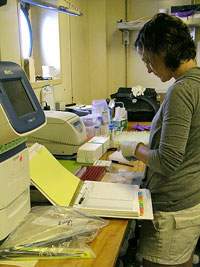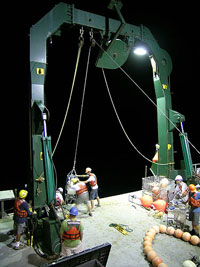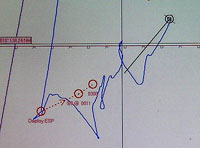- C-MORE Home
- What is Microbial Oceanography?
- What is C-MORE?
- Research
- • Research Cruises
- » BioLINCS
- Home
- Cruise Participants
- Instruments Used
on the Cruise - Nitrogen Cycling
- Marine Microbes
- Cruise Blog
- Data Archive
- Education & Outreach
- People
- Publications
- Image Library
- Contact Us
| |||||||||||||||||||||||||||||||||||
BioLINCS Cruise Blog
Thursday, September 8, 2011
|
Craig Taylor programs an Incubating Productivity System (IPS)—a type of automated microbe incubator, in one of the labs on board the Kilo Moana. |
|
Julie Robidart works on seawater samples for genetic analysis in the laboratory. The results of these laboratory analyses will be compared with the results of analyses performed automatically by the drifting Environmental Sample Processor (ESP). |
|
The deployment of the Incubating Productivity Systems (IPS) and the Submersible Incubation Device (SID) was quite complicated. Three incubators, several surface instruments, and three different floatation systems, were all connected on a single cable that was almost 200 meters long. The University of Hawai‘i marine technicians and the ship’s crew did a great job of getting all this gear in the water without tangling anything. |
|
This image shows a close-up view of the Kilo Moana’s track across the ocean (blue line) since we deployed the Environmental Sample Processor (ESP) last night. You might say that both the ESP and the ship are “going with the flow.” |
|
This photo, transmitted to the ship by the Environmental Sample Processor (ESP), shows groups of glowing dots that indicate what kinds of microbes are present in the seawater 25 meters below the surface. In this case, the ESP only detected one group of organisms—a group of marine bacteria called SAR-11. |
Last night was a busy night for many of the science crew here on the Kilo Moana. After the deployment of the ESP (described in yesterday’s blog), there was a CTD cast, and then a drifting incubation experiment called a “gas array” was deployed. I think the gas array was deployed around 2 AM, but I’m not sure because I didn’t stay up to see it all.
It is becoming apparent that for the next couple of weeks, much of my life, and the lives of many others on board, is going to revolve around CTD casts. For one thing I have been signed up to help with the physical process of launching the CTD array, as well as helping with the computer system that tells the CTD array to collect water at different depths. But more importantly, each CTD cast brings water for the microbiologists on the cruise.
Each time the CTD array arrives back on deck, researchers gather around the 24 bottles of seawater to collect water samples from different depths in the ocean. Some researchers only need a few milliliters to examine under a microscope or run through a flow cytometer. Others need dozens of liters for their incubation experiments on board the ship. Many of the researchers collect seawater from the CTD array, place this seawater in incubation chambers, and then add chemicals that will allow them to measure nitrogen uptake or other biochemical processes.
In some cases, the incubation chambers are placed back in the ocean, hanging down from small drifting buoys at the sea surface. The goal is to return the microbes (in the seawater) back to the environment from which they came, and let them incubate down there for a while (typically 24 to 48 hours). Eventually the chambers are brought back on board the ship so the researchers can then study how the microbes used various nitrogen compounds. The “gas array” that was deployed some time after midnight last night was one of these drifting incubation instruments.
We recovered the gas arrays and deployed more of these types of instruments tonight. Some of the incubation instruments must be deployed and recovered at night because even brief exposures to bright sunlight can affect the growth or behavior of microbes that are used to the perpetual twilight that exists 100 to 200 meters below the sea surface. On the recommendation of one of the researchers, I took a mid-afternoon nap so that I could stay up to see some of the action tonight (but I still have to get up to help with a 6 AM CTD cast tomorrow morning).
This evening we deployed three cutting-edge incubation instruments that do not require bringing water samples back to the surface. These are the Incubating Productivity Systems (IPS) and the Submersible Incubation Device (SID). Both are robotic microbiology laboratories that are lowered down into the ocean to incubate microbes without direct human intervention. They were designed by teams from Woods Hole Oceanographic Institution (WHOI), and are being operated by Craig Taylor of WHOI and Deniz Bombar of UC Santa Cruz.
The IPS can automatically collect a sample of seawater, label the water with tracer chemicals, incubate the microbes in that water for a set amount of time, and then collect these microbes on a filter, as well as collecting the water that passes through the filter. The instrument then adds preservatives to the filters and the filtered water so that they can be analyzed in the laboratory back on the ship or on shore. After each run, the instrument flushes its incubation chambers and starts over again, allowing researchers to observe how microbial activity in the ocean changes over time.
On this cruise, two IPS instruments will be used to measure microbes take up labeled ammonia. The microbes turn the ammonia into nitrite, and then nitrate—a process called “nitrification.” The two IPS instruments were deployed about 125 meters below the surface, where nitrification is believed to be most intense.
The Submersible Incubation Device (SID) was suspended from the same cable, but only about 25 meters below the surface. The SID works similarly to the IPS. However, instead of measuring nitrification, the SID is set up to measure nitrogen fixation (the update of labeled nitrogen gas). The SID will also measure the uptake of labeled carbon, an indicator of “primary production.” Primary production is a measure of how much inorganic carbon is being converted into the tissue of living photosynthetic organisms such as marine bacteria or algae.
The SID is suspended at the same depth as the ESP. We had intended to deploy them close together, but as it is they are about three miles apart. The idea is that the nitrogen fixation measurements from the SID can be compared with the ESP’s measurements of genes related to nitrogen-fixing microbes.
For most of the day, we’ve been able to see the big yellow float of the drifting ESP perhaps a mile or so from the ship. In fact, our general goal has been to follow the ESP, which is drifting northwestward at about half a mile an hour. The idea is that we will be sampling more or less the same water with our 25-meter CTD casts as the ESP, the IPS, and the SID are sampling with their automated drifting systems.
From a practical perspective, this means that the Kilo Moana has basically been doing quite a bit of meandering. You can see the ship’s course as the jagged blue line on the accompanying screen shot from the ship’s navigation computer.
Ever since the ESP went into the water, the ESP team has been monitoring the instrument by radio. They have watched it collect samples, and run experiments, and have even received some of the results back. The black and white photo at right shows the results of one of the ESPs recent run. This photo shows a close up view of a “hybridization array” that is less than a centimeter across. Each dot in this array indicates the presence or absence of a certain type of microbe.
The three brightest dots in the photo are “control” markers, which show that the instrument is working properly. The two sets of four dots at the top of the image indicate that a group of marine bacteria called SAR-11 are present in the water. The fact that none of the other dots are glowing suggests that there are not many other microbes out there at the moment.
The ESP crew has also been somewhat nervously watching data from instruments that measure the movements of the ESP as is hangs below its float, as well as the tension on the cable between the ESP and the float. With the benign sea conditions we’ve been having, the ESP has not been moving very much, and the cable has had little stress. However, the team plans to keep a close watch on the weather and on the data from the mooring. If the sea conditions become hazardous or anything goes wrong with the ESP, we might try to recover the instrument. That’s another reason the Kilo Moana has been following the ESP around the ocean all day.
Tomorrow we’ll be putting yet more drifting instruments into the ocean. The fun continues…
[ Top of Page ]








